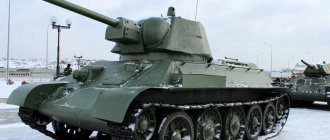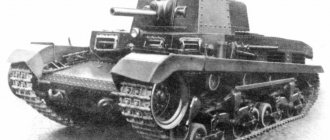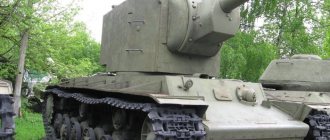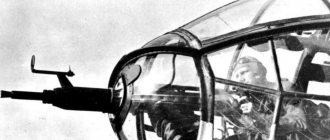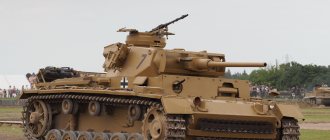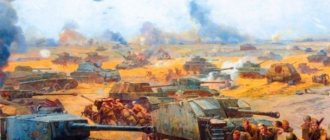The Soviet medium tank T-34 76 became the most important combat unit of the USSR during the Great Patriotic War, thanks to a large number of successful design solutions and discoveries.
Of course, one cannot say that the T-34 turned out to be an ideal machine, but the simplicity of its design, ease of repair and amazing unpretentiousness in battle made it possible to become a truly great weapon. Of course, not without the heroism of domestic tank crews, who often sacrificed themselves and showed miracles of the Russian spirit and ingenuity.
History of the creation of the T-34 tank
The history of the creation of the T-34 is closely connected with the history of the creation of the A-20.
After the A-32 was chosen as the basis for the future tank, it was ordered to increase its armor to 45 mm. But they did not waste the metal in vain and first checked its performance characteristics by simply loading ballast corresponding to the mass of additional armor plates.
T-34-76
T-34-76 in Poznan
T-34-76 in winter
T-34-76 in attack
T-34-76 in battle
Column T-34-76
T-34-76 on the march
Shot down T-34-76
Monument T-34-76
Shot down T-34-76
Shot down T-34-76
Abandoned Damaged T-34-76
The T-34-76 crew prepares the tank for battle
T-34 with F-34 gun
T-34
T-34-76
T-34-76 in battle
T-34-76 inside
Captured T-34-76
T-34-76 captured by the Germans
The new tank with increased armor received the factory designation A-34. In October-November 1939, the entire plant worked tirelessly. The government strictly set the task of building 2 models of the tank by November 7, so that they could take part in the parade. However, the tanks were never built on time. The main difficulties lay in the production of armor plates. When bent, cracks appeared in certain places. The large size (at that time) of solid armor plates also made working on them much more difficult.
Scheme T-34 mod. 1940
T-34 model 1940 crew
Meanwhile, on December 19, tests of the loaded A-32 ended. On the same day, a decree was issued “On the adoption of tanks, armored vehicles, artillery tractors and their production in 1940 by the Red Army.”
Extract from this resolution about A-32 (T-32):
“...The T-32 tank is a tracked tank, with a V-2 diesel engine, manufactured by plant No. 183 of the People's Commissariat of Srednemash, with the following changes:
Assign a name to the specified T-34 tank...” a) increase the thickness of the main armor plates to 45 mm; b) improve visibility from the tank; c) install the following weapons on the T-32 tank: 1) F-32 76 mm caliber cannon, coaxial with a 7.62 mm caliber machine gun; 2) a separate machine gun for the radio operator - 7.62 mm caliber; 3) separate 7.62 mm machine gun; 4) anti-aircraft machine gun of 7.62 mm caliber. Assign a name to the specified T-34 tank...”
Later, one of the conditions for the adoption of this tank was to overcome a 2000-kilometer range. The first A-34 (the future T-34) rolled off the plant's assembly line in January 1940, and the second in February. And immediately they were sent for factory mileage testing. However, after 250 km, the engine of the first one broke down, which further slowed down the “winding up” of the mileage.
By the end of February, the first car had covered 650 km, and the second – 350. It became clear that by March it would not be possible for each car to cover 2 thousand km, and yet state tests were scheduled for March. An emergency meeting was called at the plant, at which it was decided that the tanks would go under their own power to Moscow. This way they will cover the mileage and be on time. The chief engineer and designer of the machine, Mikhail Ilyich Koshkin, was appointed head of the expedition.
On the night of March 5th and 6th, the convoy set off. It included 2 A-34 tanks and two Voroshilovets tractors, one of which was equipped for sleeping places, and the other for a variety of spare parts and fuel. The route was strictly “secret”, bypassing all settlements and bridges. The first breakdown occurred approximately 80 km after the start of the run. One of the tanks had a broken clutch, which made the tank's movement impossible. Koshkin decided not to wait until the tank was repaired, but decided to move on, having first called a team from the factory for repairs.
The first tank arrived in Moscow on March 12, and already on March 17, both tanks were presented to the government on Ivanovo Square in the Kremlin. This unprecedented transfer had a serious impact on the health of designer Koshkin. He fell ill with pneumonia and died on September 26, 1940 in the Zanki sanatorium, where he was treated.
Stalin personally approved the car and said to provide all the necessary HTZ for mass production of the tank. The tank was put into service on June 7, 1940 and was produced until 1958. In the Russian Federation, the tank was officially withdrawn from service only in 1993. Some modifications of the tank are still in service in a number of countries in Africa, Southeast Asia and Latin America.
Design
The T-34 76 tank had a major influence on the course of the Second World War due to design solutions that were unique for its time. For the first time, a long-barreled gun was installed on a medium tank. This move made it possible to significantly exceed all analogues existing at that time in terms of initial projectile speed (612 m/sec) and, accordingly, penetrating force.
One of the main design moves in the T-34-76 is considered to be a surprisingly optimal combination of angles of inclination of the frontal and side armor.
Thanks to this, it was possible to increase the survivability of the tank. The diesel power plant, which produced 500 hp, helped to win a big design victory. (19.2 hp per ton of weight), which was an advanced indicator of that time.
Along with obvious advantages, the T-34 also had disadvantages. The design included little space for the crew. The tank commander and mechanic had poor visibility. And the hatch for the driver, located on the frontal armor, turned out to be a big design mistake, as it increased the vulnerability of the tank. No less problematic was the transmission, which often failed.
Often, due to the special rush in production (for obvious reasons, since the country was in a state of war), a lot of defects and outright defects left the factory. This also left an imprint on the overall reliability of the machine.
The layout of the tank was classic. The engine was located in the stern, and in the front there was a place for the driver and radio operator. The tank commander's position was in the turret, to the left of the gun. He served as a gunner. The loader was located to the right of the gun. In total, the vehicle crew included 4 people.
The bow of the tank hull was protected by 45 mm armor.
A periscope viewing device was installed on the driver's hatch. The course machine gun was protected by an armored cap. The entire body was made of eight rolled armored sheets welded together. Six of them were mounted at different slopes to the vertical (frontal - 53° and 60° to the horizon, side top - 40°, rear - 45° and 47°). And only the side lower armor was made strictly vertical.
The rear and side armor was 40 mm thick. Later it was strengthened, making it 5 mm thicker. The upper part of the hull under the turret varied in thickness from 16 to 20 mm. Bottom – 13 mm.
The cast turret of a tank, which is ingrained in the minds of the average person, does not correspond to reality. Turrets were cast only for heavy tanks, such as the KV1 and IS-2, and there were few of them.
For the T-34-76, a welded turret was made from rolled armor plates. In the upper part there was a hatch for the crew, as well as a ventilation hole and a PT-6 periscope sight. The side and rear sheets were installed at an angle of 30°. The rear part was protected by a removable armor panel, which was necessary for replacing and repairing the gun. The thickness of the frontal armor of the turret was 45 mm.
The tank received five pairs of road wheels. The drive wheels were located at the rear. Small-link caterpillars were made using the same technology as for the BT tank. However, the width exceeded the prototype and reached 550 mm.
The tank received a 76 mm L-11 gun with a barrel length of 2.32 meters.
The gun's ammunition load was 77 rounds, and for the most popular models of 1942-1944 it was expanded to 100 rounds (thanks to the optimization of stowage technology). The gun was mounted on trunnions in the front of the turret, paired with a 7.62 mm DT machine gun (the same was in the bow of the hull).
The supply of ammunition for machine guns was 2898 or 3087 pieces (and on models without a radio station it reached 4725 pieces).
Armament of the T-34 tank
Since the original L-11 cannon was quickly replaced by the F-34, we will focus on the characteristics of the F-34.
Weight of gun, kg – About 1700 Ammunition, st. — 77 Initial flight speed of an armor-piercing projectile, m/s, — 662 Initial flight speed of a sub-caliber projectile, m/s, — 950 Initial flight speed of Oskol.-High-explosive. projectile, m/s, - 680 Sighting range, m, - 1500 Vertical aiming angles, degrees: -5° +28° Armor penetration: Degrees of inclination are measured in relation to a horizontal surface. Armor-piercing, At a distance of 500 m, mm/deg. — 84/90° Armor-piercing, At a distance of 1.5 km, mm/deg. — 69/90° Sub-caliber, At a distance of 500 m, mm/deg. — 100+/90° Rate of fire, rds/min – up to 5 Additional weapons: Two DT machine guns. One is paired with a gun, the second is a course gun.
Chassis
The tank had five pairs of large diameter road wheels. The guides and support rollers were rubber-coated, and the caterpillar chain was fine-linked from thirty-seven flat and thirty-seven ridge tracks. On the outside, each track had lug spurs. Two spare tracks and two jacks were attached to the rear of the hull. Four pairs of rollers on board had individual spring suspension; the springs were placed at an angle and were welded to the sides in the housing.
Tactical and Technical Characteristics of the T-34 tank
Weight, t - 25.6 Crew, h - 4. Commander (aka gunner), Loader, Gunner-Radio Operator, Mechanic-Driver. Case length, mm — 5920 Case width, mm — 3000 Height, mm — 2405
Booking
Degrees of inclination are measured relative to the vertical. Body forehead (top), mm/deg. 45 / 60° Body forehead (bottom), mm/deg. 45 / 53° Hull side (top), mm/deg. 40 / 40° Hull side (bottom), mm/deg. 45 / 0° Hull stern (top), mm/deg. 40 / 47° Hull stern (bottom), mm/deg. 40 / 45° Bottom, mm 13—16 Hull roof, mm 16—20 Turret forehead, mm/deg. 45 Gun mask, mm/deg. 40 Tower side, mm/deg. 45 / 30° Tower stern, mm/deg. 45 / 30° Tower roof, mm 15 / 84°
Ride quality
Engine power, l. With. — 500 Maximum speed, km/h — 54 (According to other sources — 48). Cruising range on the highway, km - 300 Specific power, l. s./t - 19.5 Climbability, degrees. — 36°
How much does the AT-2 tank weigh?
The World of Tanks game is a great opportunity to at least “virtually” control tanks and other military equipment. The AT 2 tank is a fifth-level combat unit of the British development branch (tank destroyer class).
General characteristics of the “combat monster”: weight 44 tons, 57 mm gun, 26 rounds per minute, speed 20 km/h. The crew consists of four people. The tank can be used to push the flanks of enemy units. However, you should take care of your cover from your allies. The accuracy of the AT 2's gun is low, so using the tank for long-range attacks is not recommended.
The weight of the AT-2 tank is 44 tons.
Now you know how much the tank weighs, and as you can see, its weight depends on the modification. In addition, to determine the weight of a tank, you do not need to weigh it, but rather calculate the mass, taking into account the density of the metal and the weight of the combat equipment.
Modifications and vehicles created on the basis of the T-34
T-34M - Began to be created due to comparison with the German tank Pz III Ausf.G, which was superior to the 34 in some respects. To improve the smoothness of the ride, a new engine was developed, but the power remained the same. After reworking the arrangement of internal components, the weight and length of the vehicle were reduced, and the ammunition load was increased to 100 rounds. The tank was put into service on May 5, 1941 to replace the standard T-34 model 1940, which was then in service. However, production could not be organized due to the outbreak of the war.
T-34-57 — A new 57 mm ZiS-4 cannon has been installed. It had better characteristics than the F-34. The tank was positioned as a “Tank Destroyer”. Officially, the tank was not accepted for service due to the excessive power of the gun (for 41-42). In 1943, 85-mm guns of greater power appeared. However, only 50 were produced.
T-34-57 undergoing testing
T-34-76 model 1941 - New turret with 52 mm thick walls and two hatches on the turret roof. But one of the most important innovations is the installation of a new 76-mm F-34 cannon.
T-34-76 mod 1941 - first on the right
T-34-76 model 1942 - A new turret shape has been developed. Thanks to the new turret, the ammunition capacity has increased to 100 rounds, and the projectile resistance has also increased.
T-34-76 model 1942
T-34-76 model 1943 - New air cleaners for the engine. New shock absorbers. New caterpillars. New gearbox. For the first time, a commander's cupola from the KV-1S was installed on the tank. The tank is also supplemented with all sorts of little things to “improve the quality of the vehicle.” Entered service on June 15, 1943.
T-34-76 model 1943
PT-34 - PT-3 mine trawl installed on the T-34.
PT-34
T-34-85 - See main article.
T-34-100 - Installed 100 mm D-10T gun. A 100-mm LB-1 cannon was also developed specifically for the T-34. By increasing the caliber of the gun, the turret was enlarged and the chassis was slightly redesigned. Not accepted for service due to the start of work on a more advanced T-54.
T-34-100 in winter 1945
Other equipment based on the T-34:
OT-34 - Flamethrower tank. The crew has been reduced to 3 people. The radio operator gunner has been removed. Entered service in 1942.
OT-34 looked little different from the serial T-34
SU-122 - Self-propelled artillery unit. The self-propelled gun is equipped with a 122-mm M-30S howitzer. Entered service at the end of 1942.
SU-122 with troops near Kharkov. August, 1943
T-43 - See main article.
SU-85 - Tank destroyer. 85 mm caliber gun D-5S. Entered service in August 1943.
SU-85M column in East Prussia. January, 1945.
SU-100 - Tank destroyer. 100 mm D-10S gun. Entered service on July 3, 1944.
SU-100 near Berlin. In the background is a T-34-85. April 30, 1945.
SU-101 and SU-102 - Tank destroyers. Designed to replace the SU-100. The SU-101 was equipped with a 100 mm D-10S gun, and the SU-102 was equipped with a 122 mm D-25-44S gun. They differed from the SU-100 in having stronger armor. Not accepted for service due to severe cramping inside the vehicle and the war having already ended.
SU-101 at the training ground. Autumn, 1942.
T-34T - Tractor . Entered service in 1942.
SPK-5 - Self-propelled slewing crane. Adopted into service in 1952.
TM-34 - Bridgelayer. Entered service in 1942.
T-100 - Egyptian modernization of the T-34 tank. Converted into a tank destroyer with a 100 mm BS-3 gun. Adopted into service in 1967.
T-100 in the Egyptian Museum.
Type 65 (Not exactly) - air defense installation. Equipped with two 37 mm cannons. Nothing is known about adoption.
Type 65
How much does a Maus tank weigh?
The Maus tank was created in 1943 and weighed about 188 tons. This is a real “heavyweight” of German tank building, the length of its gun reached 2.5 m. And the total length of the combat “Mouse” was about 11.5 m! The vehicle's ammunition load included two twin cannons (128 mm and 75 mm). The capacity of the Maus fuel tank is 2650 liters. The number of crew members is five people.
This is interesting!
On these pages you can find out: How much a bear weighs How much gold weighs How much a sumo wrestler weighs How much a cloud weighs How much a piano weighs
Despite the impressive size and weight of the Maus tank, almost all the free space inside was occupied by numerous instruments and parts. So the crew of the combat vehicle had to be located “on a residual basis.”
According to the results of field tests, the Maus achieved good performance: a speed of 20 km/h, overcoming a rise, a vertical obstacle 76 cm high at an angle of 30 degrees, crossing a water trench 2 m wide.
True, all the efforts spent on creating and improving the types of this model were in vain. At the end of 1944, by order of Hitler, work on heavy tanks was stopped, and in the spring of 1945, prototypes of the 205 type were prepared for defense of the training ground in the event of capture by the Red Army. After the war, the two surviving Type 205 tanks were transported to Leningrad, and from there to the tank training ground in Kubinka.
Combat use of the T-34
The T-34 received its first combat experience in the Great Patriotic War. By the beginning of the war, a little more than a thousand vehicles had been produced, and there were 926 Thirty-Fours in the border districts.
The meeting with new Soviet tanks (T-34 and KV) was a real surprise for the German troops. In terms of its combat characteristics, the T-34 was superior to almost all Wehrmacht tanks available at that time, but the crews’ poor knowledge of new equipment, tactical miscalculations in the use of tanks, and a shortage of ammunition, fuel and repair and maintenance equipment negated all advantages.
In the chaos of the first months of the war, most of the vehicles were simply abandoned due to breakdowns or lack of fuel. And in general, the share of “thirty-fours” compared to the BT-7 and T-26 was very low.
The situation changed in the fall of 1941, when the number of T-34s in the troops increased significantly and they began to pose a much more serious threat to German tanks, as evidenced by numerous evidence from the opposite side.
By the end of 1941, the T-34 had already become the main Soviet tank, playing a key role in all major battles. Since 1942, more T-34s have been produced than all other Soviet tanks combined. Such recognized tank aces as D.F. fought on the T-34. Lavrinenko (52 destroyed German tanks in 2.5 months - the best result among Soviet tankers), V.A. Bochkovsky, N.D. Moiseev, K.M. Samokhin, A.F. Burda and others.
Up until the Battle of Kursk, the T-34 continued to outperform almost all German tanks, but in the summer of 1943 the situation changed. The appearance of new German tanks and tank destroyers significantly weakened the position of the T-34, which ultimately led to the appearance of the T-34-85 modification, which gradually began to displace the T-34 with a 76-mm cannon from the troops. By the beginning of 1945, there were practically no T-34-76s left in the army. A number of them took part in the defeat of the Japanese army.
Battle of Kursk
The largest tank battle in the history of World War II is the Battle of Kursk. About 8,000 tanks took part in the battle; the battle area was 150x200 km, most of which was previously occupied by fertile fields. The encirclement and capture of half a million Soviet soldiers near the city of Kursk was the last chance for the German command to turn the tide of the war. The extensive operation was prepared for three months; large forces of the fascist army flocked to Kursk: 780 thousand people, 10,000 guns, 2,500 tanks.
However, the Soviet army could not help but notice such regroupings and also pulled together forces, and much larger ones at that. The Soviet Union gathered about 2 million people, 25,000 guns and more than 5,000 tanks. Trenches were dug along the Kursk Bulge; more than 400 km were dug. anti-tank trenches, minefields have been prepared.
PT-SAU "Jagdtiger" - Hitler's monster suffered a colossal collapse |
On July 5, 1943, USSR artillery opened fire on German positions. Moreover, this was done exactly an hour before the start of the planned large-scale German operation. Only an hour after the planned time, having recovered from the unexpected attack, the German tank forces moved forward.
Contrary to the expectations of the Germans, the breakthrough failed, and the offensive met desperate resistance. By the end of the day, in the southern part of the front, the German 4th Panzer Division advanced only 15 km, the 9th Division in the north - only 10 km, while suffering heavy losses. Over the course of two days, the battlefield was littered with tens of thousands of dead, hundreds of burned and dying tanks.
From July 13, when the command of the German troops decided to retreat, the Soviet army launched a counteroffensive, and actually took the initiative to wage war until May 9, 1945. It is worth noting that victory in the Battle of Kursk was more likely not a consequence of success in battle, but rather the presence of significant large reserve forces. If you compare losses on both sides, it is easy to see that German military units suffered less than Soviet ones. Thus, losses on the part of the USSR amounted to:
- killed, captured, missing – more than 250 thousand people;
- wounded - more than 600 thousand soldiers and officers;
- losses of tanks and self-propelled guns - 6,064 units.
From the German side these figures look like this:
- killed, missing – more than 100 thousand people;
- wounded - 433,933 soldiers and officers,
- losses of tanks and self-propelled guns - 2,900 units.
T-34 in the cinema
Despite the very large number of T-34-76 produced, few copies of this tank survived after the war. Therefore, in films, this tank is almost always replaced by the T-34-85 modification, as was the case, for example, in the famous series “4 Tankers and a Dog” or in the film “Hot Snow.”
Authentic copies of the T-34-76 are present in the following films:
• “Two Soldiers” • “Ivan Nikulin - Russian Sailor”; • “The Great Turning Point” (T-34-76 model 1942 was shown with and without a commander’s cupola); • “Lark” (for this film the T-34-76 was specially reconstructed at the Lenfilm studio).
Frame
In 1940, the T-34 hull was made from rolled armor plates. In the front part of the front plate there is a driver's hatch with a hinged lid. Further, in the upper part of the hatch cover, there is a central viewing device for the driver, and on the left and right there are side viewing devices installed at an angle of sixty degrees to the longitudinal axis of the car. On the right is the embrasure of the forward machine gun in a ball joint. The machine gun does not have an armored mask. The rear inclined sheet of the hull is removable and is attached to the side sheets with bolts. It has a rectangular hatch for access to the transmission compartment. On the side of the hatch there are two oval openings with exhaust pipes, protected by armored caps.

